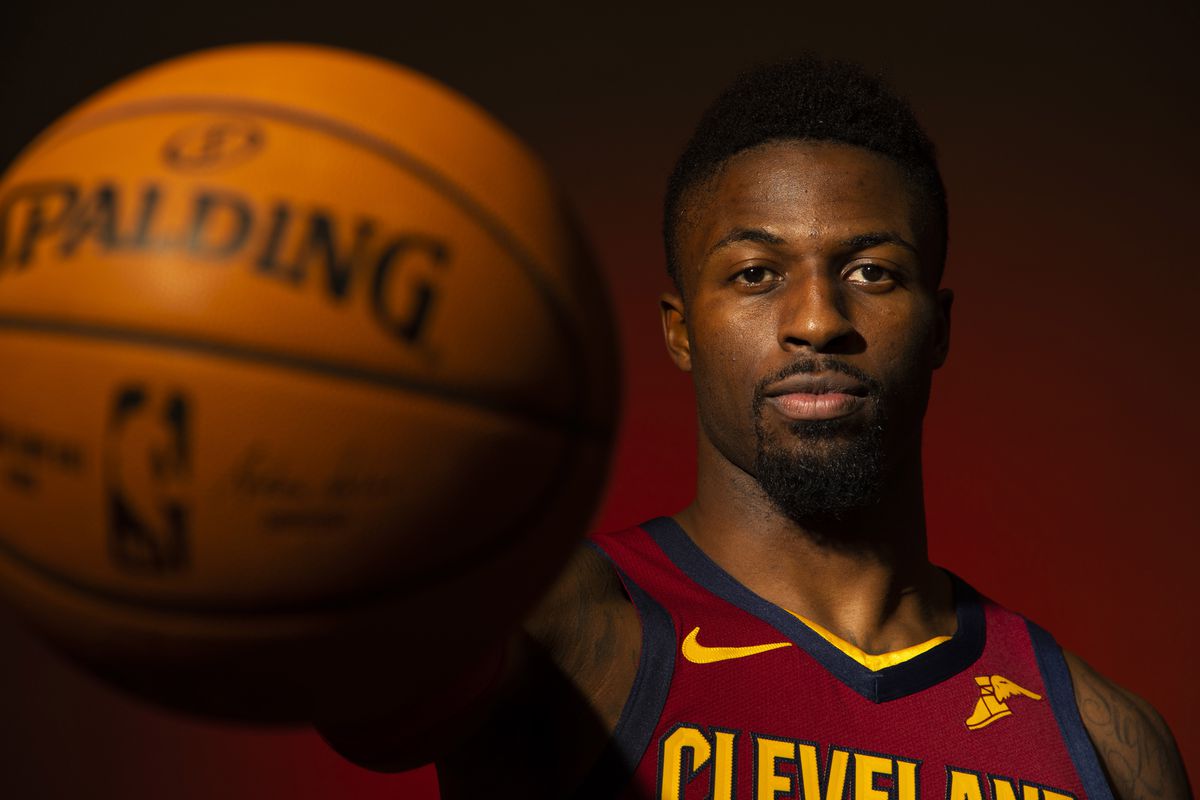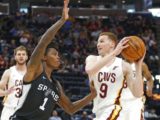
Finding Fits: 2019 Edition
2019-06-30With the start of free agency in the NBA, if there’s one thing we know for sure, it’s that the Cleveland Cavaliers won’t be signing any big names. Or any medium-sized names either. With no cap space and only two roster spots currently available, the Cavaliers will be scraping the bargain bin. In the case of a team that’s relatively early in it’s rebuild, that’s not necessarily a bad thing. Channing Frye is retiring, JR Smith will be traded or waived, and both Nik Stauskas and Marquese Chriss are likely on their way out the door. David Nwaba will be an unrestricted free agent after the Cavs decided not to give him a qualifying offer. Three of those spots will be filled by the Cavaliers’ three first round picks, Darius Garland, Dylan Windler, and Kevin Porter Jr.. While waiving Smith would bring the Cavaliers under the tax, they are unlikely to use their mid-level exception as they need to avoid repeater tax penalties. Therefore, the team will likely focus on younger players with some upside who could turn into rotation pieces if they develop properly. Finding these players for the league minimum is easier said than done. Players aren’t available for the league minimum unless they have struggled in the past for have significant flaws in their game. Still, there are a couple of players who Koby Altman and John Beilein might find intriguing. Be warned, there is nothing sexy about this list. Also, due to the glut of point and combo guards already on the Cavaliers’ roster, we will be ignoring players who qualify as such. They also have an abundance of big men, but I decided to include a few anyways.
David Nwaba
Spencer Davies mentioned a few weeks ago that the Cavaliers likely wouldn’t be giving Nwaba a qualifying offer as he and the team had an understanding on that before he signed with them last summer. While that makes it seem like Nwaba is out the door, the Cavaliers are reportedly open to re-signing him for the right price. Nwaba wants a multi-year deal, and the Cavs should give it to him. He was easily their best perimeter defender (and arguably their best defender, period) and is a great athlete who can finish at the rim and get to the line with good frequency. Nwaba is a good rebounder, solid passer, and an underrated cutter. He’s also upped the frequency of his three-point attempts, although that area of his game is still a work in progress at best. Bringing back Nwaba should be the Cavaliers’ number one priority in free agency this summer.
While he has had his moments from time to time, Hezonja has mostly struggled during his NBA tenure. Taken fifth overall in the 2015 NBA Draft, the book Hezonja was thought to be a big two-way wing with range who would be able to crash the boards and create for himself, and maybe a bit for his teammates. Now, he’s just a big wing who’s solid on the boards. The defense is inconsistent and the shooting and playmaking have never materialized at the NBA level. The thought here is that Hezonja is 24 years old and has the time and pedigree to possibly still be something in the NBA if he’s willing to listen to his coaches. It’s more likely he won’t pan out, but on a favorable deal, Hezonja may be worth the risk.
The Cavaliers already took a look at one Phoenix Suns draft bust in Chriss, they might as well look at another. Despite having spent three years in the NBA, Bender won’t turn 22 until this November. He’s shown glimpses of potential as a floor spacing big man who can facilitate for others and protect the rim a bit, but no consistent results. Indeed, the rough moments have far outweighed the good. When you take a flier on a player like Bender, you’re hoping that his lack of development has more to do with the instability within the Suns’ organization than it does with the player himself. That didn’t turn out to be the case with Chriss, but things could be different with Bender.
Johnson wasn’t tendered a qualifying offer by the New Orleans Pelicans and is an unrestricted free agent at just 23 years old. Cavalier fans may remember him from his trash talk to LeBron James during the Cavaliers 2015 sweep of the Detroit Pistons in the first round of the playoffs. Johnson played fairly well during that series, but hasn’t come close to replicating that offensive consistency since. Johnson has been a horrid offensive player during his four seasons in the NBA, shooting just 37% from the field and 29% from deep. He also has an extremely limited handle, limiting his ability to get to the basket and two the line. His redeeming qualities are on the defensive end, where he uses his size (6’7″ 245 pounds) and athleticism to guard multiple positions effectively. Johnson’s willingness to be coached has been called into question over the years, but if the Cavaliers think he can buy in, then he wouldn’t be the worst developmental project on a minimum deal.
After a season in which he shot career lows on both two and three-point attempts as well as from the free throw line, the Brooklyn Nets decided not to give Hollis-Jefferson a qualifying offer, making him an unrestricted free agent. Hollis-Jefferson will likely get a decent enough deal from a team that values his ability to guard at least four positions, but nothing is guaranteed. Every season a few solid role players fall through the cracks and have to settle for minimum deals. If Hollis-Jefferson is one of those guys this season, then the Cavaliers should jump all over him. He’s two years younger than Nwaba, and is longer, more athletic, and an even better defender. It’s unlikely that Hollis-Jefferson will ever become much of a shooter from deep, but his motor and dedication make him the type of player a team focused on development like the Cavaliers should be after. They were linked to him before the 2015 NBA Draft, and now might be the time for the Cavs to get their man.
Like Nwaba, Vonleh was on this list last season, and like Hollis-Jefferson, he would have to fall through the cracks to get to the Cavaliers because he’s certainly earned more than a minimum deal. After floundering through his first four seasons in the NBA, Vonleh found his stride with the Knicks last season, averaging 8.4 points, 7.8 rebounds, and 1.9 assists in a career-high 25 minutes per game. He also shot a career-high 53% on two-point shots and finally began shooting threes with two attempts per game. Compared to Chris Bosh and LaMarcus Aldridge coming into the NBA, Vonleh will likely never approach that level, but he has shown that he can be a very good rotation big as he enters his age 24 season.
Kornet can shoot it, especially for a big man, isn’t a bad passer, and can block a shot or two, but that’s about it. He can’t dribble, struggles to score inside the arc, and has neither the quickness to guard the perimeter nor the bulk to bang inside. Still, there’s nothing wrong with taking a flier on a young stretch big and working with him to try to develop some of the other aspects of his game. If he can improve his scoring and defending inside to anywhere near average levels, Kornet could be a rotation player in this league for a long time.
A former teammate of Cedi Osmans with Anadolu Efes, Korkmaz came to the NBA with a reputation as a very good outside shooter with enough size to play both wing positions. So far, only the size has been there. After shooting just 29% from deep as a rookie, Korkmaz improved to 32.6% last season, and also saw a huge jump in his efficiency on two-point shots. While that improvement was nice it wasn’t enough to keep Kormaz in the 76ers’ rotation, and he played in just two games after the All-Star break after playing in 46 before. Korkmaz isn’t a high level passer, and until his frame fills out, he’ll be limited defensively. Watching him, there’s no doubt he has skill and a decent basketball I.Q., but he’s also very raw. Could John Beilein and his staff help develop Korkmaz into the player so many think he can be? It would be interesting to find out.
Diallo always plays hard, and that had started to pay off in the NBA, or at least it looked like it had. Considering his efficient scoring, high-level rebounding, and improving defense, it was surprising that the Pelicans didn’t extend a qualifying offer to Diallo. After all, his play last season showed that he was worth at least that, if not much more. In some ways, Diallo is reminiscent of a young Tristan Thompson. He has a nose for the boards and finishes well around the basket, but has limited range and will also have some random turnovers. If Thompson or another big is traded this offseason, Diallo would make an ideal replacement.
Glenn Robinson III
Robinson will likely be playing for his fourth team in six seasons, the definition of a journeyman. It’s not so much that Robinson is a bad player, he isn’t. It’s his inability to stay healthy. Robinson has battled ankle problems and other health issues, and has played more than 47 games just once in his career. When healthy, Robinson shows potential as a weak side three-point shooter and cutter with the size to be an effective defender. At 25 years old, some team will take a chance on him. Would a reunion with Beilein, his college coach, combined with the medical staff at the Cleveland Clinic help Robinson find the health and consistency that have eluded him so far? It’s certainly worth finding out.
If there’s a cautionary tale out there about drafting De’Andre Hunter, it’s Justin Anderson. Like Hunter, Anderson was a big wing at Virginia that many saw as having elite 3-and-D potential. While he has had his moments in the NBA, particularly on the defensive end, Anderson has yet to really establish himself after four seasons in the league. Obviously, Hunter is considered a better prospect than Anderson was, and it’s also fair to say that some team should still take a chance on Anderson. He’s got decent length, good strength, and has shown some improvement as a shooter. While he’ll turn 26 early in the season and isn’t the youngest prospect, he still have time to carve out a niche as a rotation player somewhere in the NBA. The Cavaliers could use a player with the kind of tools and potential that Anderson has, and he seems like the type of player that a clear role combined with a staff focused on player development could be huge for. We know the Cavaliers won’t be big factors in this summer’s free agent bonanza, and that’s okay. With some smart moves and a little luck, they could still find some players who could be part of the team’s future for years to come.



So nice to see Windler play so unselfishly…they have been guarding him tight, and he’s been making smart decisions…
So many terrible shots….it’s like watching 5 18 year old Jordan Clarksons most of the time…
Quinn Snyder looks even more like a serial killer in that baseball cap…
geesus h.. this is pathetic
why didn’t we grab the trombone player?
Man these commentators are trash. They just said, there’s Collin Sexton as the camera panned to KPJ.
so, cavs are actually looking at these guys, or they just needed some teammates for windler?
https://twitter.com/BobbyMarks42/status/1146224117127012352?s=20
https://twitter.com/AmNotEvan/status/1146227171498872832?s=20
Yesterday’s recap is up.
great pocket pass Windler, JaCorey Williams has had a few good passes to the corner 3 as the roll man.
I like how unselfish Windler is…
leads team in assists right now in this game.
Windler looks like one of the best 2-3 players on the floor…
nice look ahead Windler
Tony Bradley has two fouls, only 8 more until he’s fouled out!
These guards are incapable of generating looks for anybody else. Hopefully not a regular season preview
none of these guards are going to be playing in the regular season lol
Naz making his shots tonight!
Naz has some snazz!!
Windler is back in!
Take him to the Zoo Zoosman! 😉
If Kawhi goes to the Lakers it will obviously be incredibly annoying. But anything less than a championship will be an abject failure. If they do fall short? (Chef’s kiss)
Just tuned in… Windler with a nice 3 and Long with a great drive. Seems like there’s also more energy with the guys tonight.
Summer league is a tough watch but I’m watching!
It would be better if they were playing guys that will actually get minutes during the season. When Windler sits, I lose interest.
Yep
Soooo many missed layups
If Utah and Orlando can host summer leagues, then Cleveland should as well.
So I owe CLF an enormous apology for not posting his recap today.
You are history’s greatest monster.
😂😂😂
all good Nate!
Man, think we’re all going to love Windler…dude can just play. Not just a shooter…also athletic as hell…
Yeah I’m digging his game.
Windler Trey!
Someone get the broadcasters a list of the 2019 draft
This Cavs team the last two nights seems like a serious summer league team aside from Windler…
thx for the free trial fubo tv tip.. kcp playing tonite?
Nope.
why not? psychotherapy?
Psycho-hip-flexor
kpj..
No he’s out with a hip flexor
They keep saying Windler was the 20th pick in the draft.
MIKEO -HOPE YOU ARE WRONG BUT TOTALLY UNDERSTAND THE FRUSTRATION ——–STILL I AM “ALL IN ” WITH WHAT BUCK SAID EARLIER/ AM REALLY GOING TO ENJOY WATCHING THIS YOUNG TEAM GROW TOGETHER ALONG WITH THE COACH ………….GUESS I WOULD NEVER GO AS FAR AS ROOTING FOR A PLAYER TO GET INJURED BUT HELP LIKE HELL THAT THEY CANNOT PLAY / MESH TOGETHER CREATING ” STEROID ‘ DRAMA
Sounds like Kawhi is probably going to the Lakers. Gotta say, if that happens, I’m rooting for injuries. I never have done that, but I’m so tired of stacking teams like this, especially Lebron and his Klutch muscle.
Dudley to Lakers
Jared “the Dud” Dudley!
https://twitter.com/katywinge/status/1146134338628661248?s=20
https://twitter.com/Trevor_Lane/status/1146142260104351744?s=20
https://twitter.com/wojespn/status/1146191047803965440
I saw Anthony Tolliver to Portland. A big who can shoot should help them.
https://twitter.com/JonKrawczynski/status/1146178329747296256?s=20
Probably a good deal for them. Vonleh finally showed signs of maybe being an NBA player last year…
WCS a decent fit for GSW. Whom I can now hate fully now that Iggy is gone & Livingston is likely gone as well.
They pull a lot of crap with injuries. That needs to be punished.
Not sure how GS keeps signing guys, but whatevs…
https://twitter.com/ShamsCharania/status/1146175608403181568
Was a guy I wanted the Cavs to pursue
Me, too. A solid risk/reward play for them. With little risk.
Can always sign vet min deals. And your MLE/Room can be split up.
https://twitter.com/ZachLowe_NBA/status/1146169024268722179
https://twitter.com/ThompsonScribe/status/1146164304388882432
https://twitter.com/KendrickPerkins/status/1146101667307372545?s=20
Gotta love Perk. It is an interesting point.
https://twitter.com/PatLance21/status/1145822377852506113
Probably for Canton:
https://twitter.com/AlexKennedyNBA/status/1141937318812626945
Oops this was awhile ago.
Cavs Sign Dean Wade To Two-Way Contract: https://www.hoopsrumors.com/2019/07/cavs-to-sign-dean-wade-to-two-way-contract.html
https://twitter.com/br_betting/status/1146113699314204673?s=20
DO YOU THINK THE CAVS WILL PURSUE ANY PLAYER ——–MY PLAYER ALL ALONG HAS BEEN HOLLIS -JEFFERSON
According to Fedor, they will not. They are not using their MLE.
THINK ALOT OF TEAMS HAVE GONE INTO THE DRAFT / FREE AGENCY WITH THE IDEA “TANKING ” DOES NOT WORK WITH THE MODERN NBA DRAFT RULES —–TEAMS ARE LOOKING AT SIGNING FREE AGENTS TO BE SOMEWHAT COMPETITIVE AND POSSIBLY STILL HAVE A SHOT AT HIGH DRAFT PICK